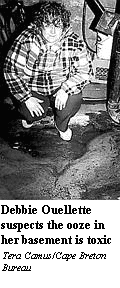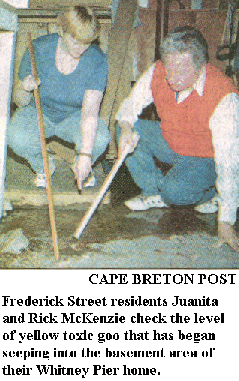Woman terrified by ooze in cellar
By Tera Camus / Cape Breton Bureau, April 30, 1999
 Sydney - Debbie Ouellette cried Thursday when she recalled the day
three weeks ago that her worst fear came true.
Yellow ooze bubbled into the basement of her Frederick Street home
after several days of rain. She believes the ooze contains the same
toxins found metres away from her back door last year.
Sydney - Debbie Ouellette cried Thursday when she recalled the day
three weeks ago that her worst fear came true.
Yellow ooze bubbled into the basement of her Frederick Street home
after several days of rain. She believes the ooze contains the same
toxins found metres away from her back door last year.
The largest yellow patch, about a metre by 20 centimetres, in her
basement is near a large drainage pipe on the cement floor. Three
other spots of yellow ooze are higher up on the basement's brick wall -
near the steps, and on the east and south walls.
There's also a pungent and slightly offensive smell that dominates a
scent of mildew.
"What about my children?" Mrs. Ouellette said, sobbing on the
shoulder of environmentalist Elizabeth May outside her back door,
moments after showing the ooze. "I know this is not a mansion, but
this is my home."
She then looked up and over at the patches of yellow grass and the
yellow ooze on the embankment less than 10 metres from the back of
her home.
It's in the exact spot where a similar yellowish deposit last year was
found to contain arsenic at 18 times the acceptable limit, plus high
levels of lead, copper, antimony, molybdenum, benzopyrene and other
polycylic aromatic hydrocarbons.
"This ooze in the basement . . . she can't spend another night in this
house," Ms. May said.
"The government has to move this family and all the families on
Frederick Street who want to move, now. Not after they make plans,
not after they spend another couple of months or years discussing it;
they have to move these people right now, today."
The provincial Environment Department went to the site Thursday
and is investigating the ooze in Mrs. Ouellette's basement and outside
her house. But there are no plans to move the family.
"At this stage, the Department of Environment is handling it," said
Transportation Department spokeswoman Janet Brison, whose
department has taken the lead in cleaning up the nearby coke ovens
site.
"There's no decision in terms of relocating the residents."
Ms. May said it was only a matter of time before ooze got into homes.
"This is the last straw; they have to be moved tonight."
Across the street, Juanita McKenzie also discovered crystallized white
and orange residue in her basement where water recently entered and
dried. She believes the residue contains toxins from the coke ovens
site.
"To me, it's something out of the X-Files," Mrs. McKenzie said.
"It's more than words can say, (to describe) how I feel," she said after
showing reporters the residue. "Why do I have to prove that where I'm
living is very, very unsuitable for human life?
"I have a husband who is ill, I have a daughter who's been ill for the
past year . . . and myself.
"There's a constant supply of Gravol, Immodium and Tylenol. This is
not living."
On Wednesday, the Joint Action Group overseeing the cleanup of
Sydney's toxic wastes voted to move residents off Frederick Street by
June 1 if the provincial and federal governments have not implemented
a clearly defined separation zone by then.
"It's like I was beating my head up against a brick wall," Mrs.
McKenzie said. "You do not know what it feels like to come home
every day and see air monitors measuring the toxins in the air. You
don't understand how it feels to live there."
Provincial Health Department spokesman Richard O'Brien tried to
comfort the residents by saying they are safe, as Cantox
Environmental, hired by the province, determined last year in a study.
That study said migrating chemicals from the coke ovens site were not
a danger, although human health hazard signs posted metres from
homes were never removed.
Several JAG members at the Wednesday meeting said some of the
study's information was based on a garden study JAG commissioned
but deemed flawed.
JAG demanded Mr. O'Brien get the name of at least one of the 16
scientists Cantox claimed in its report had done the $60,000,
three-week study.
"I think it's timely to remind people of what our memorandum of
understanding is and the definition of human health," JAG member
Eric Brophy said.
"It's a state of complete physical (and) mental well-being, and for
Cantox to say there's no ill effects, it's not worth the paper it's written
on."
PUBLICATIONThe Guardian (Charlottetown), Friday 30 Apr 1999
EDITION: FINAL -- SECTION/CATEGORY: Canada/Atlantic
Officials testing ooze in Sydney basements: Residents near
tar ponds fear for safety
SYDNEY, N.S. -- Residents of Frederick Street may now have the
evidence they need to force a government-paid relocation from their toxic neighbourhood.
Federal and provincial Environment Department officials were in
the basements of two homes Thursday, taking samples of an
orange-coloured substance seeping into the homes.
``This is very scary,'' said resident Juanita McKenzie, who has
led the charge for relocation.
McKenzie and neighbour Debbie Ouellette first noticed the basement
goo about three weeks ago.
Ouellette, a mother of three children, said her family is now not
only banned from the backyard but also the basement.
The homes along Frederick Street boarder the Muggah Creek
watershed, considered Canada's worst toxic waste dump. A fence
surrounding the property includes signs warning of a human health
hazard.
It was a year ago Thursday that residents first began to complain
publicly of sore throats, vomiting and headaches -- which they
blame on the watershed area.
The area is contaminated by almost a century of chemical-laden
runoff from the nearby Sydney Steel mill and former coke ovens.
Residents want governments to pay for their relocation until the
area is cleaned up. However, a series of government-sponsored
studies concluded the residents fears are unsubstantiated.
Elevated levels of arsenic found oozing from a bank near
Ouellette's home last summer triggered the flurry of studies.
Tests also proved contamination in the yards.
"I am afraid for my family," said MacKenzie, adding the
substance has the same appearance as the arsenic discovered last
year.
Residents fear toxic goo in basements
By Steve MacInnis, Cape Breton Post, April 30, 1999
 Residents of Frederick Street may now have the
kind of evidence they need to force a
government-paid relocation from their toxic
street.
Residents of Frederick Street may now have the
kind of evidence they need to force a
government-paid relocation from their toxic
street.
Federal and provincial Environment Department
officials were in the basements of two homes
Thursday taking samples of an orange colored
substance seeping into the homes.
"This is very scary," said resident Juanita
McKenzie, who has led the charge for a
relocation.
McKenzie and neighbour Debbie Ouellette first
noticed the goo about three weeks ago in their
basements.
From previous experience, the neighbours are
certain the substance will prove to be arsenic.
Ouellette, a mother of three children, said her
family is now not only banned from the
backyard but also the basement because of
contamination.
The homes along Frederick Street boarder the Muggah Creek Watershed which
is considered Canada's worst toxic waste dump. The fence which surrounds
the property includes signs advising of a human health hazard.
It was a year ago Thursday that residents first began to complain publicly
of a multitude of illnesses - sore throats, vomiting, headaches - which
they blame on the watershed area.
There is no question of widespread contamination on the site created after
nearly a century of steel making and byproduct manufacturing. The site is
now the subject of the country's largest remediation project which is
being developed by a community-based committee - the Joint Action Group
(JAG).
But a series of government sponsored studies have concluded the residents
fears are unsubstantiated. The watershed area is not to blame for any
illnesses being experienced by the residents, according to the reports.
Elevated levels of arsenic found oozing from a bank near Ouellette's home
last summer triggered a flurry of studies concluding there was no human
health risk but high levels of toxic chemicals and metals were found.
Tests also proved contamination in the yards.
McKenzie said she'll wait for the test results and if toxic chemicals are
shown to be seeping into the basement, she'll demand government relocation
for those who want to move.
Lawrence MacDonald, regional manager for the provincial Environment
Department, said Thursday there wasn't sufficient amounts of the substance
in the McKenzie basement to get a sample for testing.
However, there was sufficient amounts in Ouellette's basement. He said the
results should be ready in about 10 days.
"We just don't know what it is and I'm not even going to guess," he
said, adding the department has been in contact with the province's chief
medical officer, Dr. Jeff Scott, to inform him of the situation.
Earlier this week, residents bordering the watershed area met with a
lawyer to discuss their options for either compensation or relocation
because of contamination.
10 members to leave JAG
Group's credibility questioned following ban of SERL workers
By Steve MacInnis, Cape Breton Post, April 30, 1999
The credibility of the Joint Action Group (JAG)
is being questioned after the departure of at least
10 members.
JAG, mandated to develop a remediation plan
for the , is under
attack for upholding a decision that banned
employees of a provincial Crown corporation
and their families from participating in the
process.
The independent ethics committee of JAG
recommended employees of Sydney
Environmental Resources Ltd. (SERL) only
have observer status for participation and they
not be permitted to sit on five JAG committees.
A JAG roundtable meeting this week upheld the
decision in a vote of 14 to 36.
“This really hurts the credibility of the JAG
process and boarders on discrimination,” said
Bill McNeil, president of the United
Steelworkers of America, Local 1064.
McNeil is among the roundtable members who
left Wednesday’s meeting when the vote was
taken.
He said a decision on whether to return to the
process will be made by the local union
executive during a meeting tentatively scheduled
for next week.
The SERL decision impacts on several unionized
steelworkers employed by the corporation.
“We (steel workers) are entwined in that whole
area. Anything that happens on that site should
involve us,” he said.
 JAG undermines legitimacy - Letter to Editor by Douglass Grant
JAG undermines legitimacy - Letter to Editor by Douglass Grant
Back to [In the News]
 Return to Main Page
Return to Main Page
![]()
 Sydney - Debbie Ouellette cried Thursday when she recalled the day
three weeks ago that her worst fear came true.
Yellow ooze bubbled into the basement of her Frederick Street home
after several days of rain. She believes the ooze contains the same
toxins found metres away from her back door last year.
Sydney - Debbie Ouellette cried Thursday when she recalled the day
three weeks ago that her worst fear came true.
Yellow ooze bubbled into the basement of her Frederick Street home
after several days of rain. She believes the ooze contains the same
toxins found metres away from her back door last year.  Residents of Frederick Street may now have the
kind of evidence they need to force a
government-paid relocation from their toxic
street.
Residents of Frederick Street may now have the
kind of evidence they need to force a
government-paid relocation from their toxic
street. JAG undermines legitimacy - Letter to Editor by Douglass Grant
JAG undermines legitimacy - Letter to Editor by Douglass Grant
![]()
